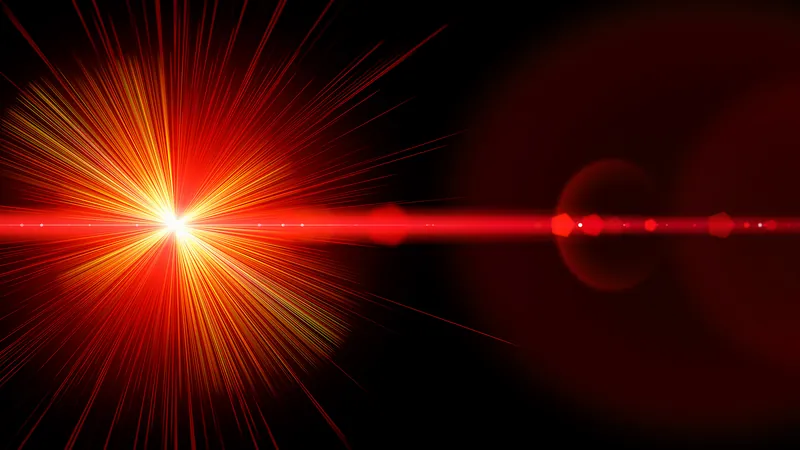
Unlocking the Secrets of the Universe: How Ultra-Intense Lasers are Transforming Plasma Physics
2025-05-19
Author: Olivia
Harnessing Petawatt Lasers to Explore Extreme Astrophysics
Imagine harnessing the power of petawatt lasers, capable of producing intensities that bring the most extreme cosmic phenomena into laboratory settings. This is no longer a dream; recent breakthroughs in laser technology have made it possible to delve into physical realms once reserved for the likes of neutron stars and black holes.
With new high-power laser facilities globally capable of reaching multi-petawatt peak powers, scientists are on the brink of unprecedented experiments. These investigations promise to explore light-matter interactions, relativistic plasma behaviors, and even the transformation of light into tangible matter and antimatter.
Creating Magnetic Fields That Rival the Strongest in the Universe
Currently, the strongest magnetic fields produced in labs can reach around 100 kilogauss with superconducting magnets. Pulsed power can push this boundary up to 1 megagauss—but only briefly and often at destructive costs. In stark contrast, the environments around magnetars—neutron stars with fields exceeding 10 gigagauss—produce magnetic conditions that fundamentally alter particle behavior.
Now, with the implementation of multi-petawatt lasers, we can emulate these extreme magnetic environments within plasmas. Thanks to a phenomenon called relativistic transparency, these lasers can penetrate significantly denser plasmas, allowing for the creation of magnetic fields stronger than ever thought possible in a lab.
Gamma-ray Beams: A Powerful Breakthrough
For years, facilities like X-ray free-electron lasers (XFELs) have been our go-to for producing high-energy photon beams. These machines use highly energetic electron beams to generate radiation, but they hit an energy cap that conventional magnetic fields impose. Ultra-strong magnetic fields from plasmas alter this dynamic, paving the way for multi-MeV photon energies.
This new method means that energetic electrons can be produced directly by the laser itself, eliminating the need for massive accelerators and creating a more compact, efficient gamma-ray source.
Transforming Light into Matter: The Breit-Wheeler Process
What if we could create matter directly from light? This isn’t science fiction—it stems from the principles of quantum electrodynamics through a process known as Breit-Wheeler. Historically, attempts to recreate this phenomenon in the lab have struggled due to the extreme intensities required.
Now, emerging laser capabilities could allow for the less-explored linear Breit-Wheeler process, where two gamma-ray photons collide to create electron-positron pairs, bypassing many previous limitations. Current simulations suggest that high-density gamma-ray beams from relativistic plasmas could yield millions of pairs—an extraordinary leap from past experiments.
Revolutionizing Detection and Applications of Positrons
But what happens to these positrons once created? In the past, they could easily annihilate with electrons before detection, but recent studies show that the same plasma field structures enabling photon interactions can also accelerate positrons. This could lead to the development of compact, efficient positron sources, vital for various applications in materials research and high-energy physics.
A New Era in Experimental Physics Awaits
With modern laser technology ushering in a new age of research, we stand at the brink of recreating phenomena generally associated with the most extreme conditions of the universe, such as those found in neutron stars or the birth of black holes.
The future promises not only fundamental scientific advancements but also practical applications, from compact radiation sources to enhanced models for understanding cosmic events. As we continue to push the boundaries of laser physics, who knows what other cosmic mysteries we might uncover?









 Brasil (PT)
Brasil (PT)
 Canada (EN)
Canada (EN)
 Chile (ES)
Chile (ES)
 Česko (CS)
Česko (CS)
 대한민국 (KO)
대한민국 (KO)
 España (ES)
España (ES)
 France (FR)
France (FR)
 Hong Kong (EN)
Hong Kong (EN)
 Italia (IT)
Italia (IT)
 日本 (JA)
日本 (JA)
 Magyarország (HU)
Magyarország (HU)
 Norge (NO)
Norge (NO)
 Polska (PL)
Polska (PL)
 Schweiz (DE)
Schweiz (DE)
 Singapore (EN)
Singapore (EN)
 Sverige (SV)
Sverige (SV)
 Suomi (FI)
Suomi (FI)
 Türkiye (TR)
Türkiye (TR)
 الإمارات العربية المتحدة (AR)
الإمارات العربية المتحدة (AR)